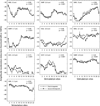Importance of cochlear health for implant function
- PMID: 25261772
- PMCID: PMC4377117
- DOI: 10.1016/j.heares.2014.09.009
Importance of cochlear health for implant function
Abstract
Amazing progress has been made in providing useful hearing to hearing-impaired individuals using cochlear implants, but challenges remain. One such challenge is understanding the effects of partial degeneration of the auditory nerve, the target of cochlear implant stimulation. Here we review studies from our human and animal laboratories aimed at characterizing the health of the implanted cochlea and the auditory nerve. We use the data on cochlear and neural health to guide rehabilitation strategies. The data also motivate the development of tissue-engineering procedures to preserve or build a healthy cochlea and improve performance obtained by cochlear implant recipients or eventually replace the need for a cochlear implant. This article is part of a Special Issue entitled <Lasker Award>.
Copyright © 2014 Elsevier B.V. All rights reserved.
Figures







References
-
- Bierer JA. Threshold and channel interaction in cochlear implant users: Evaluation of the tripolar electrode configuration. J. Acoust. Soc. Am. 2007;121:1642–1653. - PubMed
Publication types
MeSH terms
Grants and funding
LinkOut - more resources
Full Text Sources
Other Literature Sources
Medical

